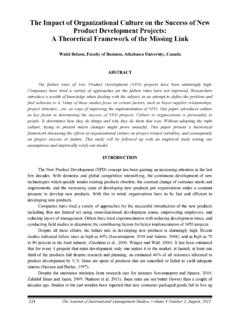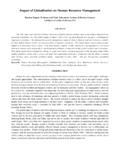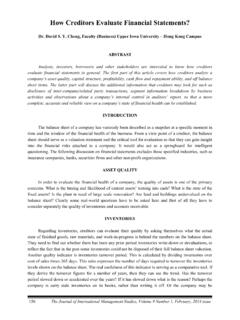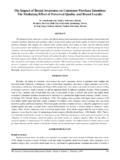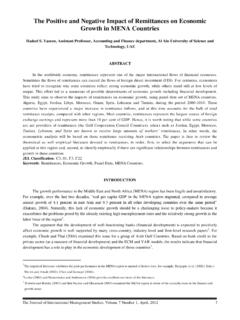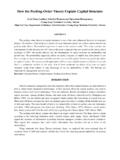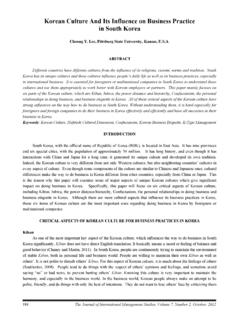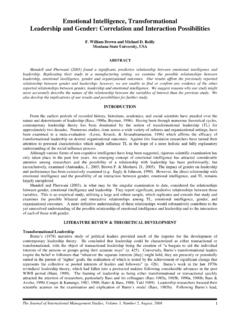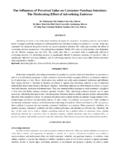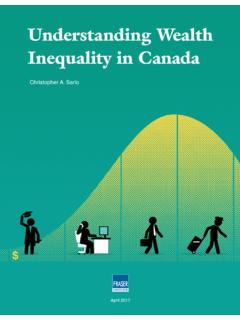Transcription of Confucius Face Culture on Chinese Consumer Consumption ...
1 Confucius Face Culture on Chinese Consumer Consumption Values toward Global Brands Warveni Jap, Marketing and International Business Faculty, Thompson Rivers University, Canada ABSTRACT. This phenomenological qualitative study explored Chinese Consumer Consumption values on global brand fashion luxuries from 61 participants who lived in Beijing, Shanghai, and Tianjin. Semi-structured Consumption behavior questionnaires, in-depth one-on-one and focus group interviews using Moustakas (1994) approach served as the primary source of data collection. The research findings were centered on Chinese Consumer Consumption values and attitudes between Confucius face concept and global brands. Also, the findings revealed that: (a) Confucius face Culture did influence Chinese Consumer Consumption values in the quest of social prestige, (b) Hofstede's collectivism [or conformity] and Chinese guanxi concept further influenced Chinese Consumption values creating a bandwagon effect, and (c) Hofstede's power distance and Schutte's Maslow's hierarchy of needs: The Asian equivalent did confirm the quest for social status needs in the Chinese market.
2 Keywords: Confucius Face Concept (or lien and mianzi), Chinese Consumer , Global Brands, Guanxi INTRODUCTION. Due to the rapid economic growth in China over the past 25 years, Chinese Consumer Consumption values and behavior tend to vary significantly based on regions, cohorts, and social class (Xiao, 2005), and also they have very different Consumption values compared to their Western counterparts (Keegan & Green, 2008). This study explored and analyzed the assumption that there were significant differences in social cultural values between Chinese and Western Consumer Consumption values. Considering that about 30 percent of the Chinese population are upper and middle-class (or 390 million people). out of billion Chinese consumers (Xiao, 2005), those young professionals and those who are new middle-class consumers wish to exhibit quickly their achievements and social status to their circles through buying and using foreign luxury fashion goods.
3 By doing so, those Chinese consumers will receive immediate social acceptance and face (or mianzi) up to the level of the social status they wish to achieve. Additionally, there is a traditional connection between invisible wealth and social status or position in Chinese Confucian face Culture (Zhang, 1996). Simons (2006) stated, In a nation that has long tradition of valuing face,'. consumers take luxury products as a symbol of their high social status. Not surprisingly, such consumers may end up heavily in-debt and remain very discontented in their life achievements (Peter & Olson, 2008). Despite its apparent importance, a review of previous research on Confucius face concept in China market identified several deficiencies. Therefore, it seems clear that additional research in this area is needed and imperative.
4 This study provided further insights to multinational corporations (MNCs), Chinese domestic firms, and Chinese consumers themselves. Furthermore, this study developed a better understanding of the spectrum of Confucius face concept that may affect Chinese consumers' Consumption values, perception, behaviors, and attitude towards global brands when purchasing luxury fashion products. Statement of the Problem Chinese consumers prefer to purchase luxury imports than domestic made luxuries that possibly may have comparable product quality, design, features, and so forth. Therefore, the problem is that Chinese consumers are willing to pay much higher (or premium) prices for global-branded and or imported luxury fashion goods to enhance and maintain their social status and self-concept (or mianzi) due to possible preconception and or overstatement about The Journal of International Management Studies, Volume 5, Number 1, April, 2010 183.
5 Global brands compared to their domestic counterparts. Furthermore, such Consumer Consumption values and behavior are even more serious for those Chinese who have recently acquired middle-class status. Namely, those Chinese consumers engage in almost pathological levels of Consumption of foreign luxury fashion goods (Peter & Olson, 2008). as they desperately purchase global-branded luxury-fashion goods seeking to acquire cultural meanings with which to construct a satisfactory self-concept (or mianzi). Therefore, many Chinese consumers purchase imported products because global brands and or imported goods symbolize higher social status, prestige, high fashion, and reliability (Wang & Chen, 2004). RESEARCH METHODOLOGY. The research design of this study used a phenomenological qualitative approach by using semi-structured focus groups and in-depth personal interviews to explore further the impacts of Confucius face Culture (or mianzi) on Chinese Consumer Consumption values, behavior, perception, beliefs, and attitudes towards their purchase intention and decision on global brands.
6 The study targeted middle class Chinese consumers who live in Beijing and Tianjin (Northern China). and Shanghai (Southern China) with a total of 61 participants. Due to time and other resources constraints, this study used the qualitative method despite its disadvantages compared to quantitative methods. Focus group interviews were used in this study. To optimize the quality of the focus group interviews, each focus group interview consisted of 8-10 participants and was about one to two hours long (Creswell, 2005; Hair, Bush, & Ortinau, 2006; Neuman, 2006; Proctor, 2005; Zikmund & Bodur, 2008). Furthermore, this study used semi-structured in-depth interviews to gain further detailed data regarding their personal Consumption values, perception, perspectives, behavior, and attitudes towards global brands.
7 Whereas, in-depth interviews refer to a deep or one-on-one interview (Hair et al., 2006). Population This study was conducted in three major China cities, namely, Beijing, Shanghai, and Tianjin. Approximately 20. participants were interviewed in each city with a total sample population of 61 participants in this entire study. Due to the nature of the study, each participant must be older than 18 years, be a middle-class individual, and have a monthly income level of more than RMB 3,500 (or equivalent to US$ 500) in Beijing and Shanghai, and RMB 2,500 (or equivalent to US$ 360) in Tianjin because of slightly different living standards among all those cities. To provide balanced representation and research findings for this study, the participants' gender proportion were recruited 46:54 between female and male, respectively (see Table 1).
8 In addition, every participant must have buying experiences of global-brand luxury fashion goods with a minimum twice a year within the past year to provide accurate and more current Chinese consumers' Consumption values, experiences, perceptions, attitudes, and behavior towards global brands in this qualitative study. Sampling China is the world's most populous country with billion citizens (Datamonitor, 2007; Xiao, 2005). Therefore, it is impossible to have a large-scale sample size to draw generalizability of the findings from this research subject. This current study was a phenomenological qualitative study that was primarily directed to understanding the complex and the elusive from a systemic perspective more than to establish unambiguous cause and effect relationships between single variables (Gummesson, 2005; Munthree & Bick, 2006).
9 To simplify and execute this study in a timely, effective, and appropriate manner, as well as for the sake of clarity, a purposeful or purposive sampling was used to recruit participants for this study. Research Questions There are significant cultural differences between the West and Chinese cultures (Hill, 2007). Therefore, this present study attempted to explore and understand more in-depth about Chinese Consumption behavior and attitudes towards global brands based on Confucius face concept. Specifically, this study attempted to understand further how 184 The Journal of International Management Studies, Volume 5, Number 1, April, 2010. Confucius face Culture (or mianzi), Chinese guanxi concept, and Hofstedes' power distance ( , inequality and hierarchy) and collectivism ( , interdependence, harmony, acceptance) interplay with Chinese Consumer Consumption values, perceptions, beliefs, behavior, and attitudes towards global brands through focus-group interviews and in-depth interviews.
10 The following are the research questions of this study, as follows: RQa: How does Confucius face (or mianzi) Culture play in Chinese Consumer purchasing process and decision? RQb: How does Chinese guanxi concept influence Chinese Consumer Consumption behavior towards global brands? RQc: How does Hofstede's power distance concept affect Chinese Consumer Consumption behavior towards global brands? RQd: How does Hofstede's collectivism concept influence Chinese Consumer Consumption behavior towards global brands? Figure 1: The conceptual framework of the study. Assumptions Due to the rapid economic growth in the Chinese market, the purchasing power and Consumption values of Chinese Consumer have been increased dramatically since the past years (Datamonitor, 2007; Hill, 2007; Xiao, 2005).
